In this post, you’ll learn everything you need to know about where to stay in Lisbon.
Lisbon is a small, human-sized capital, organized into neighborhoods that all have very different personalities.
It’s up to you to see what you are looking for and what suits you best!
The good news is that you are spoilt for choice, finding accommodation in Lisbon is not very complicated, affordable, and the city is so pleasant that you will hardly be disappointed by your neighborhood.
Which is the best area to stay in Lisbon?
Lisbon is compact and relatively small for a European capital, but its neighborhoods are actually very different from each other.
This means that where you choose to set down your luggage can totally change your view of the city.
Whether you want to be a few steps away from grand boulevards lined with restaurants, department stores, and tourists or quietly enjoying a bica (espresso) every morning surrounded by locals, here’s a guide to which of Lisbon’s neighborhoods to stay in.
Alfama – Authentic district of Lisbon
Lisbon is one of the oldest cities in Western Europe, but most of what you’ll see there was built in the 18th century.
Indeed, after most of Lisbon collapsed in the catastrophic earthquake of November 1, 1755, the rest was consumed by fire or swept away by the tsunami that passed through just after.
The old Moorish area called the Alfama, which sits on one of Lisbon’s seven hills, has miraculously survived.
For a general overview of the area, hop on the usually crowded Tram 28, from which you can see historic sites like the Sé Cathedral.
Catch the last night train to avoid the lines and see the city in a whole new light.
While an increasing number of tourists pound the limestone cobblestones of the main streets, you’ll find the authentic Lisbon by venturing down the steep alleys and small staircases.
Stroll the streets in the shade of the laundry hanging over you, say hello to the old lady selling ginja (Portuguese cherry liqueur) out her window, and let the soft, melancholy sounds of fado emanate from a small street café carry you along.
This area of Lisbon is a veritable explosion of sunshine and color, from the colorful tiled storefronts to the flowers in the windows.
Everything is breathtaking! Linger in front of the bright pink bougainvillea that adorns the Santa Luzia gazebo or stops at Portas do Sol to watch the sunset reflected on the Tagus.
Highlights of Alfama
- Castelo de São Jorge
- Sé Cathedral
- Miradouro Portas do Sol
- Tram 28
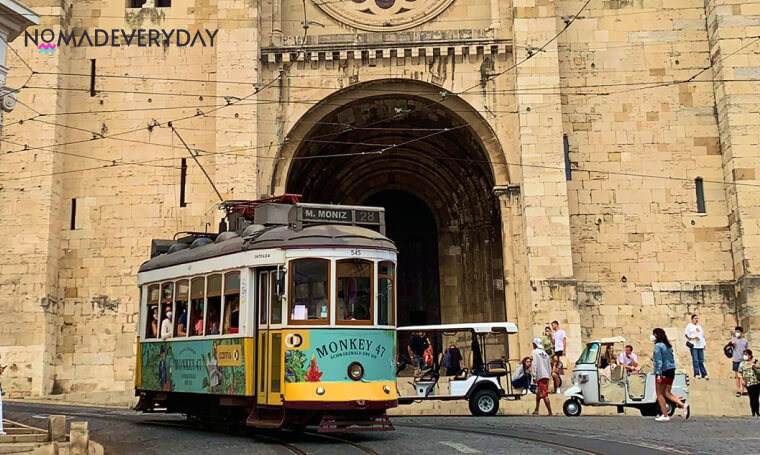
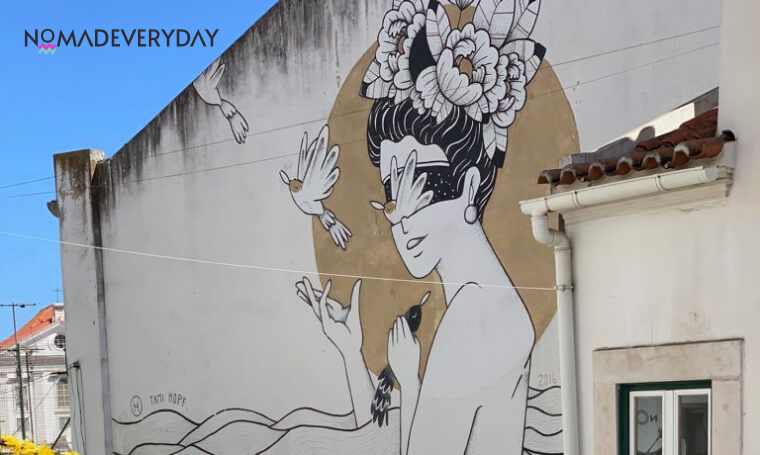
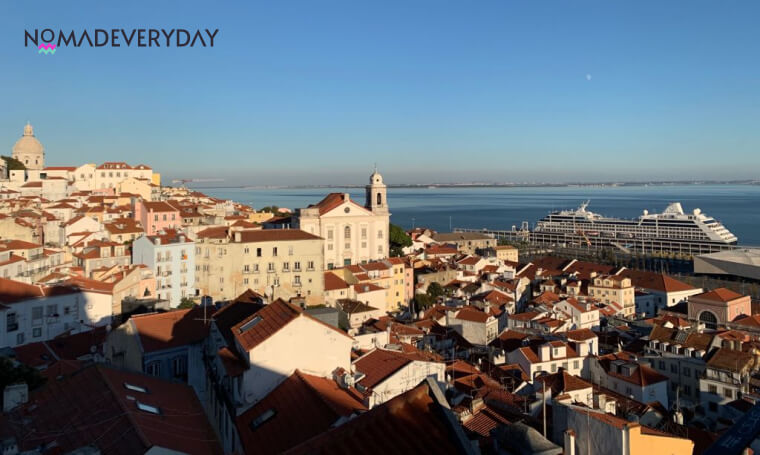
Graça – Lisbon’s inspirational district
Not far from Alfama is Graça, a popular hipster neighborhood, where you can find good restaurants for cheap.
The place is less touristy than Alfama but be aware that Graça is uphill. If you would like to stay in this area you will need to walk up!
You can walk to the center of Lisbon in 30 minutes, or take the famous streetcar 28, which goes through this charming neighborhood.
You will have the best panoramic views of all the neighborhoods of Lisbon.
Admire the horizon from the São Jorge Castle or go to the Miradoura da Graça. From there you can see the São Jorge Castle and the whole of downtown Lisbon.
The Miradouro da Graça is also worth a visit for its terrace café where you can enjoy delicious food and drinks while taking in the view.
Before you leave, take a look at the church of Graça, which has a rich baroque décor dating back to the 13th century.
And if your legs allow it, make an extra effort, a short ten-minute walk, to reach the top of the hill.
At Miradouro da Nossa Senhora do Monte, you’ll have the best view and fewer tourists to share it with.
Highlights of Graça
- Miradoura da Graça
- Grace Church (Igreja da Graça)
- Miradouro da Nossa Senhora do Monte

Baixa-Chiado – Touristy area
Baixa is the city center of Lisbon. If everything you plan to do is in the center of the city, Baixa is probably the best neighborhood in Lisbon to stay.
The ultra central and touristic district, and also the most expensive district of all Lisbon.
It is very beautiful, very clean, but also full of tourists, which can make everyday tasks such as getting to work or shopping a bit of a pain.
The Rossio train station, which you will probably use if you are planning a day trip to Sintra, is located in the middle of this neighborhood.
Unlike the old neighborhoods, the area is relatively flat (no hills), so it’s easy to walk along the main boulevards.
Mingle with the crowds, store along Rua Augusta and relax on one of the benches adorning the impressive squares lined with palaces and government buildings.
Take the elevator to the top of the Arco Triunfal da Rua Augusta for a sublime view of the avenue, Commerce Square, and the river.
And to escape the hustle and bustle for a moment, stop by the Nossa Senhora da Conceição Velha church.
Only the façade of this church survived the earthquake of 1755, so everything else was rebuilt from the ruins and old archive plans.
Highlights of Baixa Chiado
- Praça do Comércio
- Rua Augusta
- Santa Justa Lift
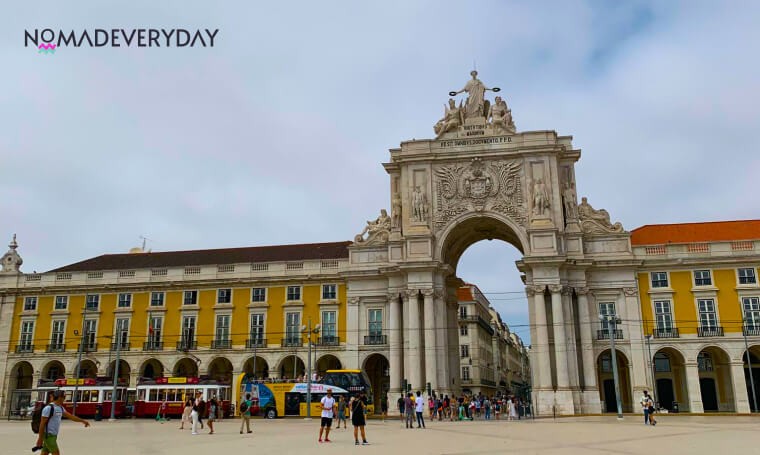
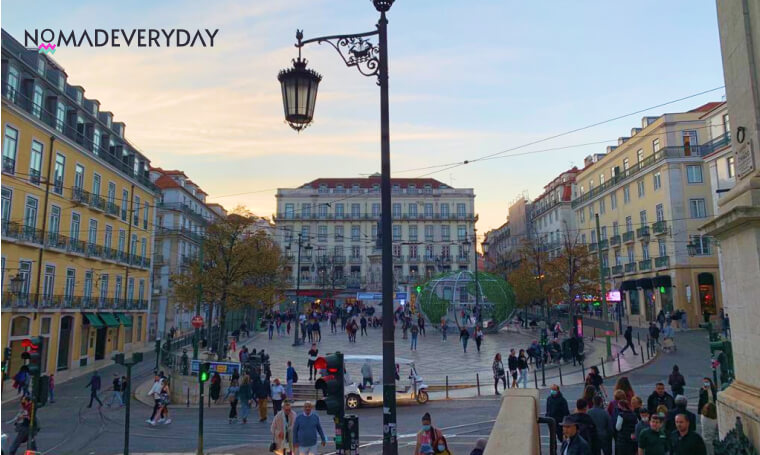
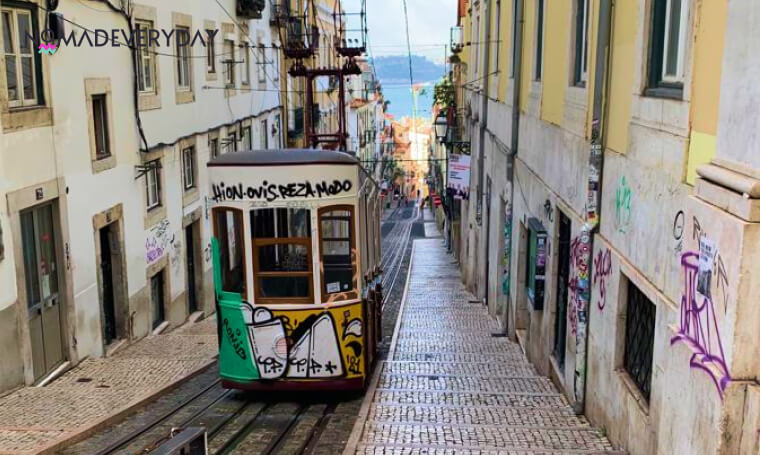
Bairro Alto – Party district
Bairro Alto is the party district of Lisbon. If you would like to stay in this neighborhood note that it’s a noisy area.
It is a very small neighborhood made up of a multitude of cobbled streets, caught between Baixa, Principe Real and Santos.
During the day, the streets are quiet and occupied by the locals who live their lives there.
There is even a school and a convent right in the middle. You will also find many restaurants for lunch.
At night, this is the party district in Lisbon, with bars popping up on every corner, closing at 2am (during the pandemic).
Living in Bairro Alto is conceivable if you are a student, but difficult if you have to get up every day at 7am to go to work.
We prefer to warn you because the noise can be disturbing for the less festive among you.
Most of the facades that were not already covered with azulejos have been given a colorful makeover by talented street artists.
The Bairro Alto is the perfect place to drink all night and meet new people. A pint is less than 1.50€ in most bars, which gives you some financial leeway.
Highlights of Bairro Alto
- Rossio
- Elevador da Bica
- Convento do Carmo
- Igresa and Museu Sao Roque
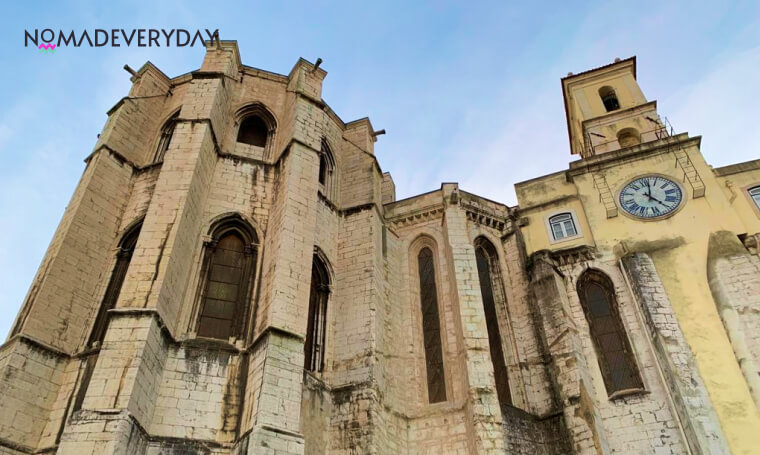
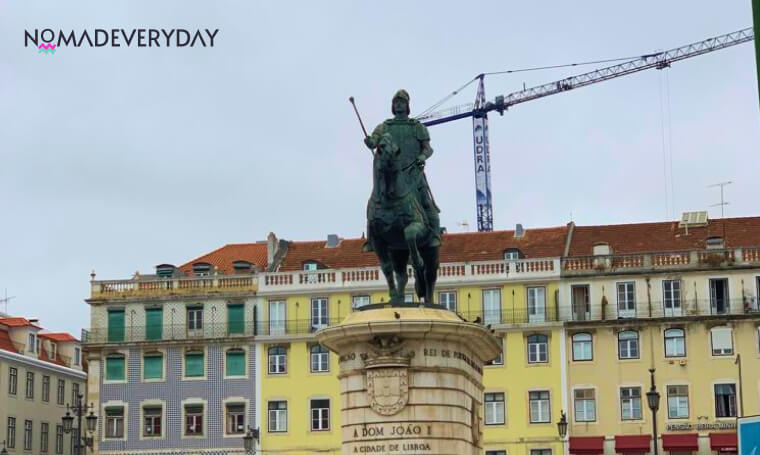
Principe Real – Trendy and chic neighborhood
At the top of one of the city’s hills, Principe Real is Lisbon’s chic, trendy and urban neighborhood.
The streets are full of hipster restaurants, small traditional bars, and design stores. You can walk to Baixa in about 15 minutes.
You’ll find parks, leafy plazas with fountains, and kiosks to sit at.
Not cheap, one of the most expensive areas of the city, but less expensive than Baixa.
It has a chic suburban atmosphere with its mansions, palace, and the many Lisboners who gather there to have a drink in the many local cafes.
This small residential neighborhood is full of charm and its streets are filled with fabulous boutiques and small stores.
Highlights of Principe Real
- Miradouro Sao Pedro de Alcantara
- Jardim Do Príncipe Real
- Convento dos Cardaes
- Botanical Garden
Intendente – The new urban quarter
Intendente is formerly a popular neighborhood that is quickly becoming the hipster stronghold of Lisbon.
There are many small bars and alternative restaurants (like the great Casa Intendente), and live music.
The streets are sometimes decrepit, but the buildings are being renovated at the speed of light.
You’ll find atypical people, good food and an array of cultural events throughout the year.
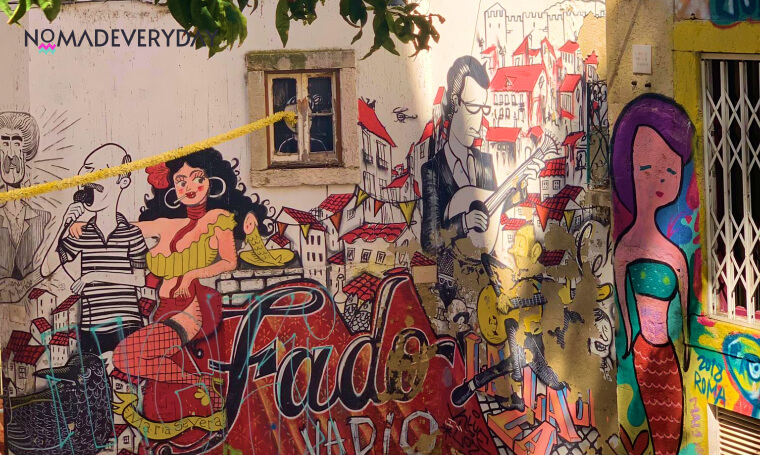
What is the coolest neighborhood in Lisbon?
Santos – Expats area of Lisbon
Santos is the “expats” area. The area is a beautiful neighborhood that both traditional and trendy.
It is located about 30 minutes walk from Baixa and just after Principe Real and Bairro Alto.
Prices are more affordable than Principe Real, but you’ll probably have to use public transportation more.
Enjoy the “traditional” alleys with colorful walls and laundry drying in the windows, and all the small, non-touristy restaurants that serve great value meals.
Also one of the best neighborhoods to be in during the famous Santo Antonio festivities in June: the streets fill up with amazing block parties!

Rato – International district
Rato is practically in Principe Real.
The metro station of the same name takes you everywhere in a few minutes.
A nice neighborhood with lots of expats and international students, a perfect mix of Principe Real and Santos.
A bit cheaper than Principe Real in terms of rent.
Estrela
At the foot of the Basilica of Estrela, and adjacent to the Rato neighborhood, you will find the Estrela neighborhood, chic and sober, whose lung is the Jardin De Estrela.
A beautiful little park with a pond, benches, two kiosks, a café and open air markets and concerts on weekends.
Is 2 nights enough in Lisbon?
Yes, in 2 days you can see all the must-sees of the city.
First of all, you should know that the Portuguese capital has a small center, except for Belém which is a bit different.
You will have enough time to visit the historical center and the emblematic monuments of Belém in a weekend.
If you only have 2 days, you can try to visit the whole historical center and Belém in 1 day, then go to Sintra on the 2nd day.
For this, you will only need to take public transportation to Belém, and take shorter breaks.
- Day 1: The must-sees of downtown Alfama, Baixa, Bairro Alto, Estrela and Belem
- Day 2: Sintra
Check out our article about Sintra: Things To Do in Sintra and What to See
What is the best month to visit Lisbon?
The best time to go to Lisbon is from May to October.
Lisbon has pleasant weather conditions almost all year round. Thus, there is not really a period to avoid when planning your trip.
From May to October is when the climate is most favorable with sunny weather and pleasant heat.
Rain is almost absent, especially in July and August.
Because of the summer vacations, the period from mid-June to September is the most popular with tourists.
Many tourists visit the tourist spots and beaches around Lisbon such as Carcavelos or Cascais.
During this season, it is best to book your stay in advance.
In addition, due to the high number of visitors, hotel and flight prices are higher. This weighs on the travel budget.
Therefore, to enjoy the mild climate in Lisbon and a calmer atmosphere, spring and autumn are perfect.
In fact, temperatures are around 20°C in April-May and between 20 and 25°C in September/October.
During these periods, prices are more affordable and tourist numbers are moderate.
However, April is the month to avoid during the Estoril Open. For a week, tennis fans flock to the tournament.
On the other hand, if you are looking for a time to go to Lisbon, winter is also a good time to stay.
The climate is relatively mild and sunny, although some rain is possible.
Average temperatures range from about 11 to 17 degrees Celsius even in the dead of winter.












Hi, this is a comment.
To get started with moderating, editing, and deleting comments, please visit the Comments screen in the dashboard.
Commenter avatars come from Gravatar.